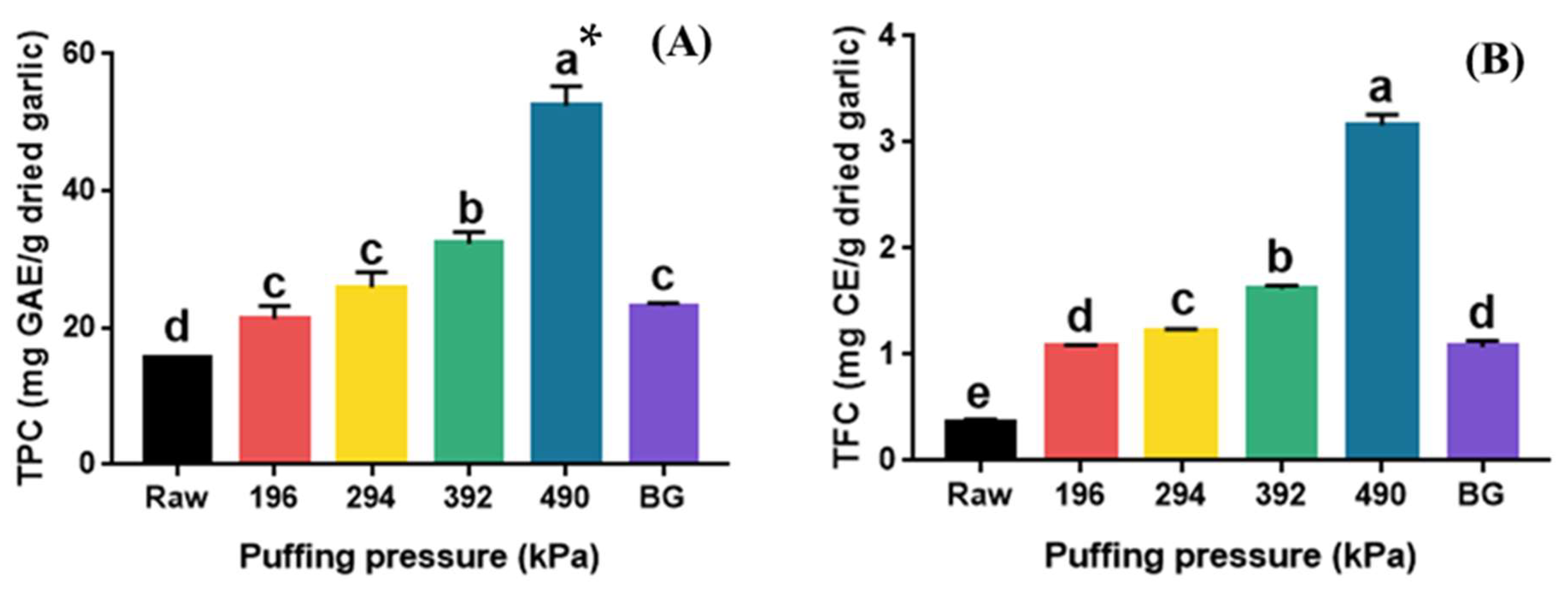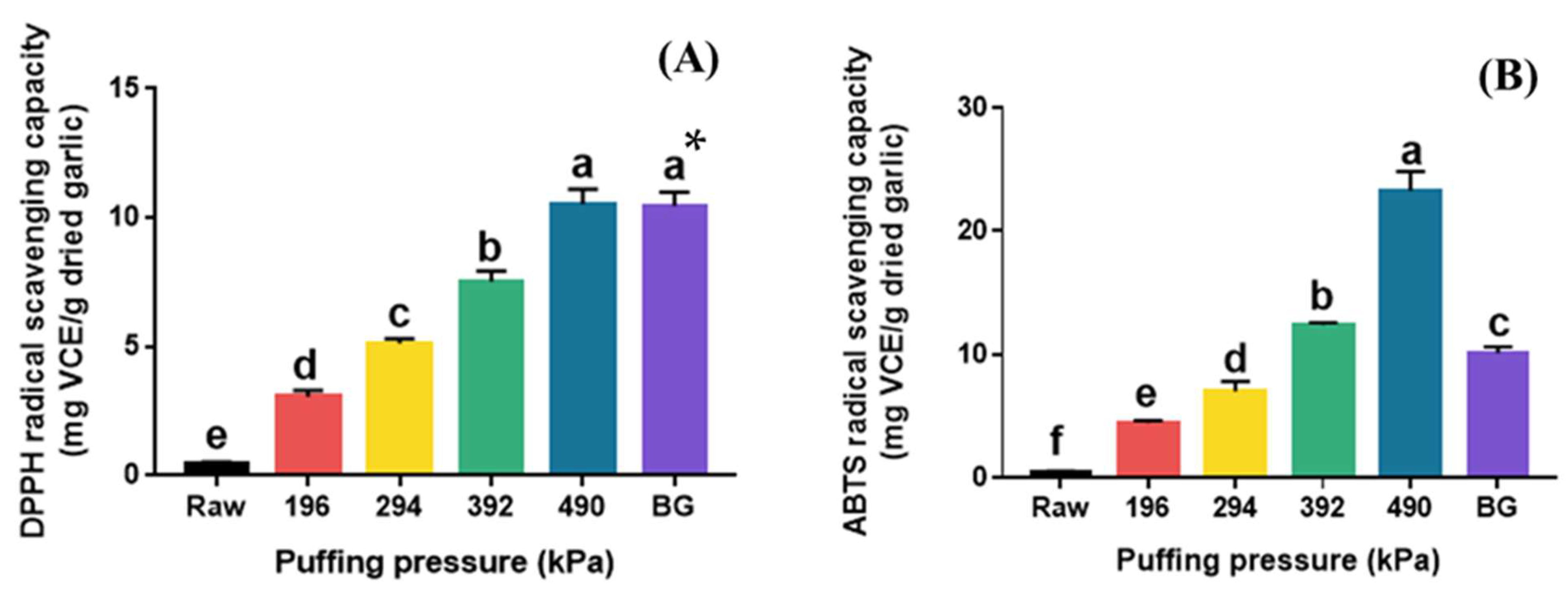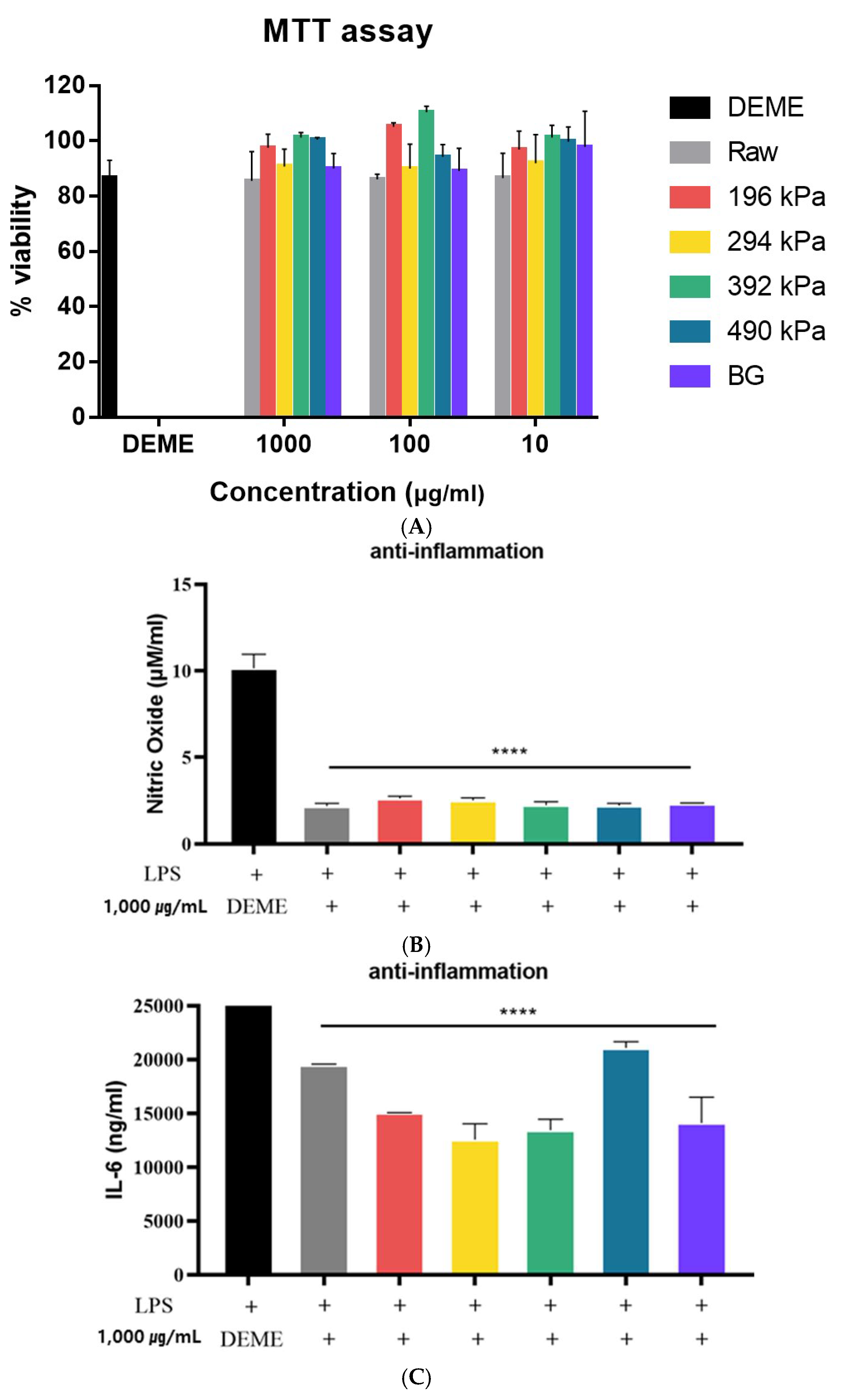Enhancing Antioxidant and Anti-Inflammatory Activities of Garlic by Puffing
Abstract
1. Introduction
2. Results and Discussion
2.1. Morphology and Extraction Yield
2.2. Maillard Reaction Products (MRPs)
2.3. Total Phenolic Content (TPC) and Total Flavonoid Content (TFC)
2.4. Antioxidant Activity
2.5. Anti-Inflammatory Activity Test
2.6. Quantification of S-Allylcysteine (SAC)
3. Resources and Methods
3.1. Materials and Chemicals
3.2. Preparation of Puffed Garlic and Black Garlic
3.3. Scanning Electron Microscopy (SEM)
3.4. Extraction Yield
3.5. Maillard Reaction Products (MRPs)
3.6. Total Phenolic Content (TPC)
3.7. Total Flavonoid Content (TFC)
3.8. Antioxidant Activity
3.9. Cell Culture and Processing
3.10. Cytotoxicity Assay
3.11. Measurement of Nitric Oxide
3.12. Measurement of IL-6 Production
3.13. HPLC Analysis
3.14. Statistical Analysis
4. Conclusions
Author Contributions
Funding
Institutional Review Board Statement
Informed Consent Statement
Data Availability Statement
Conflicts of Interest
References
- Fejes, R.; Bondonno, C.P.; Radavelli-Bagatini, S.; Kühn, T.; Wagner, K.-H. Exploring the health benefits of raw white garlic consumption in humans: A mini review. Front. Nutr. 2024, 11, 1459627. [Google Scholar] [CrossRef] [PubMed]
- Antonelli, M.; Donelli, D. Therapeutic Benefits of Red Garlic: A Narrative Review of Laboratory Studies. Biol. Life Sci. Forum 2024, 38, 3. [Google Scholar] [CrossRef]
- Popławska, N.A.; Śliz, J.; Skorupska, M.; Czeczotka, M.J.; Woźniak, K. Garlic (Allium sativum L.): A review of varied health benefits. J. Educ. Health Sport 2024, 72, 51512. [Google Scholar] [CrossRef]
- Dardona, Z.; Amane, M.; Boussaa, S. Garlic (Allium sativum): An in-depth review focusing on its potent antiparasitic activity. GSC Biol. Pharm. Sci. 2024, 28, 7–26. [Google Scholar] [CrossRef]
- El-Saadony, M.T.; Saad, A.M.; Korma, S.A.; Salem, H.M.; El-Mageed, A.; Taia, A.; Alkafaas, S.S.; Elsalahaty, M.I.; Elkafas, S.S.; Mosa, W.F. Garlic bioactive substances and their therapeutic applications for improving human health: A comprehensive review. Front. Immunol. 2024, 15, 1277074. [Google Scholar] [CrossRef] [PubMed]
- Omar, S.H.; Al-Wabel, N. Organosulfur compounds and possible mechanism of garlic in cancer. Saudi Pharm. J. 2010, 18, 51–58. [Google Scholar] [CrossRef]
- Borlinghaus, J.; Albrecht, F.; Gruhlke, M.C.; Nwachukwu, I.D.; Slusarenko, A.J. Allicin: Chemistry and biological properties. Molecules 2014, 19, 12591–12618. [Google Scholar] [CrossRef]
- Sato, S.; Sekine, Y.; Kakumu, Y.; Hiramoto, T. Measurement of diallyl disulfide and allyl methyl sulfide emanating from human skin surface and influence of ingestion of grilled garlic. Sci. Rep. 2020, 10, 465. [Google Scholar] [CrossRef]
- Kim, S.; Park, S.-L.; Lee, S.; Lee, S.-Y.; Ko, S.; Yoo, M. UPLC/ESI-MS/MS analysis of compositional changes for organosulfur compounds in garlic (Allium sativum L.) during fermentation. Food Chem. 2016, 211, 555–559. [Google Scholar] [CrossRef]
- Wang, B.; Zhong, Y.; Wang, D.; Meng, F.; Li, Y.; Deng, Y. Formation, evolution, and antioxidant activity of melanoidins in black garlic under different storage conditions. Foods 2023, 12, 3727. [Google Scholar] [CrossRef]
- Alihanoğlu, S.; Karaaslan, M.; Vardin, H. Novel Nutritive Garlic Product “Black Garlic”: A Critical Review of Its Composition, Production and Bioactivity. Harran Üniversitesi Mühendislik Derg. 2017, 2, 57–63. [Google Scholar]
- Krisnawan, A.H.; Budiono, R. The effects of processing time on the total phenolic, flavonoid content, and antioxidant activity of multi bulb and single bulb black garlic. J. Teknol. Dan Ind. Pangan (J. Food Technol. Ind.) 2022, 33, 69–76. [Google Scholar] [CrossRef]
- Martínez-Casas, L.; Lage-Yusty, M.; López-Hernández, J. Changes in the aromatic profile, sugars, and bioactive compounds when purple garlic is transformed into black garlic. J. Agric. Food Chem. 2017, 65, 10804–10811. [Google Scholar] [CrossRef]
- Wonorahardjo, S.; Sari, D.P.; Salsabila, A.; Estiyawati, E.; Yuliani, D.; Wijaya, A.R.; Suharti, S.; Kusumaningrum, I.K.; Maharani, C.A.; Noviyanti, T.A. Physicochemical changes and role of analytical chemistry in black garlic (Allium sativum L.) processing. Makara J. Sci. 2023, 27, 8. [Google Scholar]
- Hoseney, R.C. Principles of Cereal Science and Technology, 2nd ed.; A General Reference on Cereal Foods; American Association of Cereal Chemists: St. Paul, MN, USA, 1986. [Google Scholar]
- Lee, S.J.; Moon, T.W.; Lee, J. Increases of 2-furanmethanol and maltol in Korean red ginseng during explosive puffing process. J. Food Sci. 2010, 75, C147–C151. [Google Scholar] [CrossRef] [PubMed]
- Miao, X.-Q.; Huang, J.-B.; Li, Y.; Dong, X.-P.; Sun, N.; Jiang, P.-F. Dynamic changes in quality and flavor compounds of pork tendons during puffing process. npj Sci. Food 2024, 8, 87. [Google Scholar] [CrossRef]
- Choi, Y.; Ban, I.; Lee, H.; Baik, M.-Y.; Kim, W. Puffing as a novel process to enhance the antioxidant and anti-inflammatory properties of Curcuma longa L. (turmeric). Antioxidants 2019, 8, 506. [Google Scholar] [CrossRef]
- Kim, Y.-T.; Shin, J.-S.; Ye, S.-J.; Kim, J.H.; Eom, S.H.; Baik, M.-Y. Conversion of Gingerols to Shogaols in Ginger (Zingiber Officinale) by Puffing. Food Chem. 2024, 404, 139425. [Google Scholar] [CrossRef]
- Han, S.H.; Ko, B.S.; Ahn, S.H.; Noh, D.O.; Suh, H.J. Comparison of the antioxidant activities of roasted and explosive puffed coffees. Int. J. Food Sci. Technol. 2017, 52, 1417–1424. [Google Scholar] [CrossRef]
- Choi, G.-S.; Shin, J.-S.; Kim, W.; Baik, M.-Y. Increases in Ginsenoside Rg3, Compound K, and Antioxidant Activity of Cultivated Wild Panax Ginseng (CWPG) by Puffing. Foods 2022, 11, 2936. [Google Scholar] [CrossRef]
- Kim, J.-H.; Shin, J.-S.; Kim, W.; Lee, H.; Baik, M.-Y. Effects of Puffing, Acid, and High Hydrostatic Pressure Treatments on Ginsenoside Profile and Antioxidant Capacity of Mountain-Cultivated Panax ginseng. Foods 2023, 12, 2174. [Google Scholar] [CrossRef]
- Kim, J.; Lee, H.-I.; Lim, Y.J.; Park, Y.J.; Kim, W.; Kim, D.-O.; Kim, B.-Y.; Eom, S.H.; Baik, M.-Y. Antioxidant and phytoestrogenic activities of puffed black soybeans (Glycine max). LWT 2020, 118, 108780. [Google Scholar] [CrossRef]
- An, Y.-E.; Ahn, S.-C.; Yang, D.-C.; Park, S.-J.; Kim, B.-Y.; Baik, M.-Y. Chemical conversion of ginsenosides in puffed red ginseng. LWT-Food Sci. Technol. 2011, 44, 370–374. [Google Scholar] [CrossRef]
- Mao, C.; Ye, P.; Liu, T.; Song, M.; Xie, Y.; Pang, H.; Wang, Y.; Chen, X.; Wang, K.; Wang, Y. Evaluation of mechanical properties, heating rate and radio frequency explosive puffing (RFEP) quality of purple sweet potato under different moisture contents and moisture equilibrium process. Innov. Food Sci. Emerg. Technol. 2024, 93, 103611. [Google Scholar] [CrossRef]
- Shibana, S.; Jalaja, S. Comparative evaluation of garlic (Allium sativum L.) genotypes in Kanthalloor, Idukki, Kerala, India. Int. J. Curr. Microbiol. App. Sci. 2019, 8, 798–803. [Google Scholar] [CrossRef]
- Galaz Pérez, E.A. Efecto de factores ambientales precosecha en el desarrollo de la planta, bulbificación y acumulación de fructanos en ajo. Master’s Thesis, Universidad Autónoma de Querétaro, Facultad de Química, Santiago de Querétaro, México, 2008. [Google Scholar]
- Zhao, Y.; Jiang, Y.; Ding, Y.; Wang, D.; Deng, Y. High hydrostatic pressure-assisted extraction of high-molecular-weight melanoidins from black garlic: Composition, structure, and bioactive properties. J. Food Qual. 2019, 2019, 1682749. [Google Scholar] [CrossRef]
- Yu, J.; Shan, Y.; Li, S.; Zhang, L. Potential contribution of Amadori compounds to antioxidant and angiotensin I converting enzyme inhibitory activities of raw and black garlic. Lwt 2020, 129, 109553. [Google Scholar] [CrossRef]
- Montano, A.; Casado, F.J.; De Castro, A.; Sánchez, A.H.; Rejano, L. Vitamin content and amino acid composition of pickled garlic processed with and without fermentation. J. Agric. Food Chem. 2004, 52, 7324–7330. [Google Scholar] [CrossRef]
- Kim, J.-S.; Kang, O.-J.; Gweon, O.-C. Comparison of phenolic acids and flavonoids in black garlic at different thermal processing steps. J. Funct. Foods 2013, 5, 80–86. [Google Scholar] [CrossRef]
- Choi, D.-J.; Lee, S.-J.; Kang, M.-J.; Cho, H.-S.; Sung, N.-J.; Shin, J.-H. Physicochemical characteristics of black garlic (Allium sativum L.). J. Korean Soc. Food Sci. Nutr. 2008, 37, 465–471. [Google Scholar] [CrossRef]
- Chaaban, H.; Ioannou, I.; Chebil, L.; Slimane, M.; Gérardin, C.; Paris, C.; Charbonnel, C.; Chekir, L.; Ghoul, M. Effect of heat processing on thermal stability and antioxidant activity of six flavonoids. J. Food Process. Preserv. 2017, 41, e13203. [Google Scholar] [CrossRef]
- Lee, Y.-J.; Shin, J.-S.; Oh, S.-M.; Bae, J.-E.; Ye, S.-J.; Lee, H.; Kim, W.; Baik, M.-Y. Changes in Ginsenoside Composition, Antioxidant Activity and Anti-Inflammatory Activity of Ginseng Berry by Puffing. Foods 2024, 13, 4151. [Google Scholar] [CrossRef]
- Zhang, Y.; Zhou, Q. Investigation of the correlation between 5-HMF content and antioxidant activities of MRPs. China Condiment 2013, 38, 36–40. [Google Scholar]
- Atun, S.; Aznam, N.; Arianingrum, R.; Devi, Y.; Melasari, R. Characterization and biological activity test of garlic and its fermentation as antioxidant, analgesic, and anticancer. In Proceedings of the 7th International Conference on Research, Implementation, and Education of Mathematics and Sciences (ICRIEMS 2020), Yogyakarta, Indonesia, 25–26 September 2020; pp. 159–165. [Google Scholar]
- Dewi, I.P.; Wahyuni, F.S.; Aldi, Y. The Cytotoxic Effect of Ethanolic Extract of Dasun Tunggal and Garlic (Allium sativum) on Raw 264.7 Cells. In Proceedings of the 2nd International Conference on Contemporary Science and Clinical Pharmacy 2021 (ICCSCP 2021), Surabaya, Indonesia, 30–31 October 2021; pp. 30–34. [Google Scholar]
- Lee, D.Y.; Li, H.; Lim, H.J.; Lee, H.J.; Jeon, R.; Ryu, J.-H. Anti-inflammatory activity of sulfur-containing compounds from garlic. J. Med. Food 2012, 15, 992–999. [Google Scholar] [CrossRef] [PubMed]
- Singleton, V.L.; Rossi, J.A. Colorimetry of total phenolics with phosphomolybdic-phosphotungstic acid reagents. Am. J. Enol. Vitic. 1965, 16, 144–158. [Google Scholar] [CrossRef]
- Brand-Williams, W.; Cuvelier, M.-E.; Berset, C. Use of a free radical method to evaluate antioxidant activity. LWT-Food Sci. Technol. 1995, 28, 25–30. [Google Scholar] [CrossRef]
- Dudonne, S.; Vitrac, X.; Coutiere, P.; Woillez, M.; Mérillon, J.-M. Comparative study of antioxidant properties and total phenolic content of 30 plant extracts of industrial interest using DPPH, ABTS, FRAP, SOD, and ORAC assays. J. Agric. Food Chem. 2009, 57, 1768–1774. [Google Scholar] [CrossRef]
- Duan, S.; Kwon, S.-J.; Gil, C.S.; Eom, S.H. Improving the antioxidant activity and flavor of faba (Vicia faba L.) leaves by domestic cooking methods. Antioxidants 2022, 11, 931. [Google Scholar] [CrossRef]
- Kim, H.; Ban, I.; Choi, Y.; Yu, S.; Youn, S.J.; Baik, M.-Y.; Lee, H.; Kim, W. Puffing of turmeric (Curcuma longa L.) enhances its anti-inflammatory effects by upregulating macrophage oxidative phosphorylation. Antioxidants 2020, 9, 931. [Google Scholar] [CrossRef]
- Malaphong, C.; Tangwanitchakul, A.; Boriboon, S.; Tangtreamjitmun, N. A simple and rapid HPLC method for determination of S-allyl-L-cystein and its use in quality control of black garlic samples. LWT 2022, 160, 113290. [Google Scholar] [CrossRef]





| Puffing Pressure (kPa) | Extraction Yield (%) | Maillard Reaction Products (Absorbance) |
|---|---|---|
| raw | 42.21 ± 2.09 d* | 0.094 ± 0.008 f |
| 196 | 36.23 ± 0.64 e | 0.263 ± 0.018 e |
| 294 | 49.63 ± 0.24 c | 0.351 ± 0.015 d |
| 392 | 52.88 ± 0.63 b | 0.462 ± 0.005 c |
| 490 | 58.84 ± 1.06 a | 0.643 ± 0.017 b |
| BG | 21.01 ± 0.78 f | 0.674 ± 0.029 a |
| Puffing Pressure (kPa) | S-Allylcysteine (μg/g) |
|---|---|
| raw | 57.86 ± 3.45 a |
| 196 | 30.86 ± 1.46 b |
| 294 | 23.98 ± 0.15 bc |
| 392 | 17.78 ± 2.02 c |
| 490 | 4.65 ± 0.18 d |
| BG | 23.14 ± 0.61 bc |
Disclaimer/Publisher’s Note: The statements, opinions and data contained in all publications are solely those of the individual author(s) and contributor(s) and not of MDPI and/or the editor(s). MDPI and/or the editor(s) disclaim responsibility for any injury to people or property resulting from any ideas, methods, instructions or products referred to in the content. |
© 2025 by the authors. Licensee MDPI, Basel, Switzerland. This article is an open access article distributed under the terms and conditions of the Creative Commons Attribution (CC BY) license (https://creativecommons.org/licenses/by/4.0/).
Share and Cite
Yang, H.-J.; Shin, J.-S.; Oh, S.-M.; Bae, J.-E.; Ye, S.-J.; Choi, H.-W.; Baik, M.-Y. Enhancing Antioxidant and Anti-Inflammatory Activities of Garlic by Puffing. Molecules 2025, 30, 2022. https://doi.org/10.3390/molecules30092022
Yang H-J, Shin J-S, Oh S-M, Bae J-E, Ye S-J, Choi H-W, Baik M-Y. Enhancing Antioxidant and Anti-Inflammatory Activities of Garlic by Puffing. Molecules. 2025; 30(9):2022. https://doi.org/10.3390/molecules30092022
Chicago/Turabian StyleYang, Hye-Jung, Jae-Sung Shin, Seon-Min Oh, Ji-Eun Bae, Sang-Jin Ye, Hyun-Wook Choi, and Moo-Yeol Baik. 2025. "Enhancing Antioxidant and Anti-Inflammatory Activities of Garlic by Puffing" Molecules 30, no. 9: 2022. https://doi.org/10.3390/molecules30092022
APA StyleYang, H.-J., Shin, J.-S., Oh, S.-M., Bae, J.-E., Ye, S.-J., Choi, H.-W., & Baik, M.-Y. (2025). Enhancing Antioxidant and Anti-Inflammatory Activities of Garlic by Puffing. Molecules, 30(9), 2022. https://doi.org/10.3390/molecules30092022







